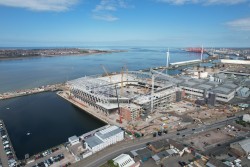Precast concrete has been a star player in the construction of sporting venues around the UK. One, perhaps obvious appeal, is precast concrete's robustness and durability.
Almost every football and rugby ground, athletics stadium and indoor arena features some form of precast component, as does much of the associated infrastructure. "Of particular concern in stadium design is the effect of resonant frequency, when a structure moves due to the dynamics of crowd movement," explains Elaine Toogood, Director, Architecture & Sustainable Design with The Concrete Centre. "The use of concrete is widely understood to limit this."
This was why precast sections were a safe choice for the terraces on iconic venues like the London Olympic Stadium. In all, 9,250m³ of reinforced precast concrete was used within the Olympic Stadium bowl and more than 12,000 precast elements were required for the seating steps alone. Besides terrace units, other precast components typically used on stadia include raking beams, staircases and step blocks, vomitory walls, hollowcore slabs, flooring and cladding panels. Modern Methods of Construction (MMC) in the precast concrete sector are now enabling the next generation of stadia.
Everton Stadium Takes Shape
Currently rising up from the banks of the river Mersey, Everton Football Club's new 52,888-seater stadium has already won numerous accolades with its eye-catching design, brilliantly blending the modern with the traditional. Nothing exemplifies this better than the precast concrete structure and terraces, a solution used in stadium design for decades but now deployed with all the benefits of MMC.
The stadium is scheduled for completion in 2024, but the primary concrete structure in all four stands is now complete. Precast concrete elements were produced offsite ready to slot together to form the floors, walls and supporting pillars of the stands. Each component was created in a specialist factory and brought to site using the modern digitally enabled process known as Design for Manufacturing and Assembly (DfMA).# It is precast concrete which will also put bums on seats with 1,217 terracing units, forming the internal bowl lining. The bespoke, double-stepped terracing units manufactured by Banagher Precast Concrete in Ireland and delivered by boat to Liverpool docks, were lifted and bolted into place by the construction team from Laing O'Rourke.
Laing O'Rourke have stated that upon completion Everton Stadium will have a real 'wow' factor having already created a virtual model of the stadium. Using Building Information Modelling (BIM), the digital version of the stadium has been mapped out in intricate detail. The model includes everything from the precast concrete walls, through to precise positioning of wiring, plumbing, light switches and plug sockets.
This digital approach allows for efficiency gains, risk reduction and leads to programme and cost benefits. It also provides a digital reference throughout the lifecycle of the build allowing for easier design of extensions or repairs. Concrete MMC also enables the linking of a model to the construction programme, the construction team can visualise the construction sequence and assess potential risks or clashes in the programme. This programme optimisation can then feed into just-intime delivery and a faster build overall.
For information on how precast concrete is shaping the UK construction sector visit: www.mpaprecast.org









